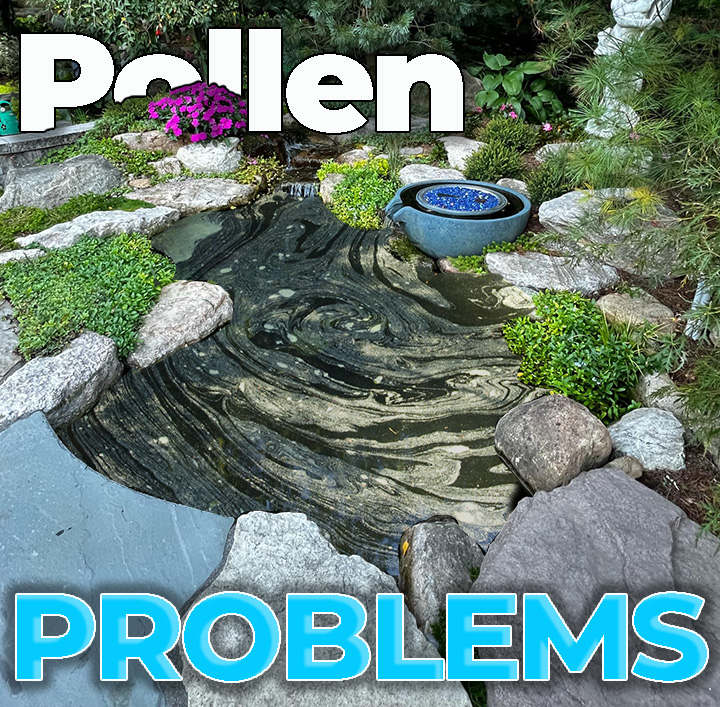New Jersey pond green in spring? 3 ways pollen wrecks it
Spring in New Jersey means blooming trees, warm breezes—and if you’ve got a pond, a sudden green haze in the water. If your New Jersey pond turns green every spring, pollen might be the invisible enemy wreaking havoc on your aquatic ecosystem.
Let’s break down exactly how pollen throws your pond off balance—and how the right mix of filtration, dosing systems, and aquatic plants can bring clarity and health back to your water.
🍃 What pollen does to your pond (and why it turns green)
You’ve seen it on your car: that yellow-green dust blanketing everything in sight. Now imagine that same pollen settling on your pond’s surface. It doesn’t just sit there—it dissolves and feeds algae.
Here’s what happens:
-
Nutrient Overload – Pollen adds nitrogen and phosphates to the water, spiking the nutrient levels that algae feed on.
-
Surface Coverage – Pollen can create a film on the pond’s surface, reducing oxygen exchange and increasing water temperature—both of which help algae grow.
-
Ecosystem Imbalance – Pollen throws off the natural balance by overloading your pond faster than beneficial bacteria can compensate.
That’s when you get that familiar, frustrating New Jersey pond green effect—cloudy, murky water and stressed-out fish.
🛠️ 1. Upgrade your pond filtration system
When pollen is driving algae blooms, your filter has to work overtime. Most basic filters just aren’t built for this level of biological stress.
✅ Add a filter bowl or pressure filter with UV clarification
✅ Upgrade to biological filtration to support beneficial bacteria
✅ Clean filters more frequently in spring when pollen peaks
UV clarifiers are especially effective—they destroy algae cells before they can multiply, and combined with strong mechanical filtration, they help restore clear water fast.
👉 Need help choosing the right filter? Explore our filter solutions
💧 2. Install a pond dosing system for daily balance
Even the best filter can’t catch everything—especially when pollen keeps coming. That’s where a dosing system steps in.
A pond dosing system automatically adds:
-
Beneficial bacteria
-
Barley extract
-
Water clarifiers
These ingredients break down organic waste and outcompete algae at the source. Best of all? It runs on autopilot. Just set it, forget it, and let it defend your ecosystem day after day.
👉 We recommend Aquascape’s dosing systems—check them out here
🌿 3. Add aquatic plants to starve algae naturally
Want a solution that’s beautiful and effective? Aquatic plants are your pond’s built-in nutrient filter.
They outcompete algae by:
-
Absorbing the same nutrients algae feeds on
-
Providing shade that reduces sunlight (algae’s fuel)
-
Oxygenating the water to support beneficial bacteria
Top picks for New Jersey ponds:
-
Floating plants: Water lettuce, hyacinth
-
Oxygenators: Hornwort, anacharis
-
Marginals: Pickerel rush, iris, cattails
Once established, plants are your strongest long-term defense against green water in New Jersey ponds.
🌤️ Tired of murky water? Here’s your spring checklist:
✔️ Upgrade your filter with UV
✔️ Set up a dosing system
✔️ Add diverse aquatic plants
✔️ Clean and skim pollen regularly
With these 3 fixes, you’ll have an ecosystem that can stand up to pollen—and keep your pond clear and healthy all season long.
📞 Want expert help clearing your pond this spring?
We’ve helped hundreds of New Jersey pond owners beat the pollen battle. Whether you’re starting fresh or upgrading what you’ve got, we can help.
👉 Contact us today for expert support
👉 Or stop by our pond supply store for filters, plants & more
Looking for more great tips, tricks and quality content? Check out our YouTube Channel!
FAQs About Green Pond Water in New Jersey
🏡 Why is my pond turning green in Essex County?
In Essex County, heavy spring pollen and nearby tree coverage are often the culprits behind green pond water. The combination of pollen, fish waste, and direct sunlight fuels algae growth quickly. Upgrading your filtration system and adding aquatic plants can make a big difference.
🌳 What can I do to clear my pond water fast in Morris County?
If you live in Morris County and want fast results, a UV filter, a dosing system, and aggressive plant coverage will help clear your pond naturally—often within a week or two. Be sure to skim surface pollen regularly in peak season.
👉 See how we help with pond maintenance in Morris County
🌼 Do I need different plants for a pond in Hunterdon County?
Not necessarily—but choosing hardy varieties like hornwort, cattails, and water lettuce can give you the upper hand. In rural areas of Hunterdon County, where pollen and runoff are more intense, aquatic plants play a major role in keeping the ecosystem balanced.
